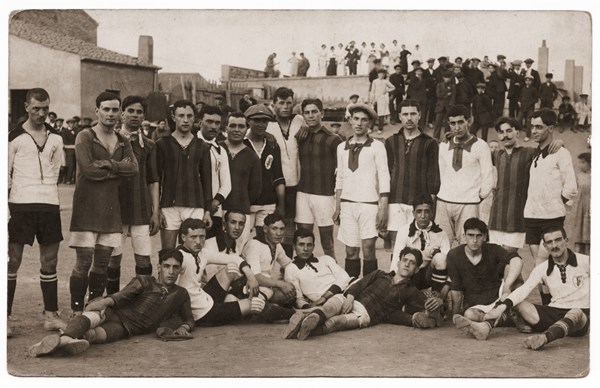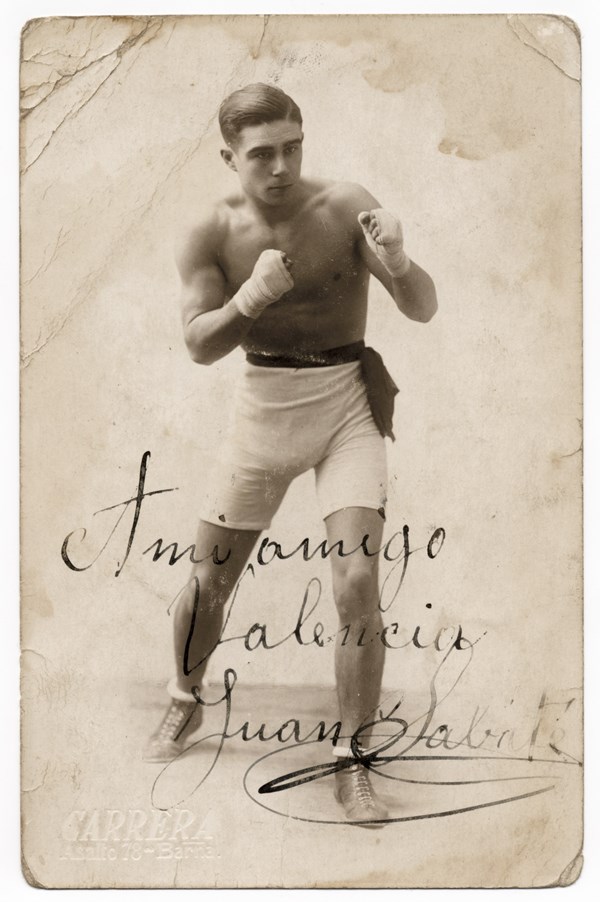Portrait of the boxer Josep Gironès. Foto Carrera. Archive of the family Carreras i Mira.
ATTENTION!
"All the boxers who have their portrait taken in Fotografía Carrera, Conde del Asalto 78, will have their photos published free in this magazine."
(Boxeo, 31 January 1928, p. 12).
This announcement, published in Boxeo, shows the close relationship there was between the photographer Ricard Carreras Casablancas (Sabadell, 1895 - Barcelona, 1975) and one of the most important sports magazines of the day devoted entirely to boxing. Ricard Carreras was one of the most active photographers working for two weekly magazines published in Barcelona, Boxeo and Boxing. But what do we know about him and the portraits he took?
Researching his professional life was no easy matter. The fact that he changed the surname by which he was to be known made us wonder at first whether it was him or someone else. Our doubts were resolved after consulting such sources as business registries, municipal records and the yearbooks of the towns and cities where he worked. It is quite possible that he chose to go by the name of Carrera in order to avoid confusion with Gabriel Carreras Barceló, who was also a photographer working in the field of portrait photography and the sale of photographic equipment in Terrassa.
Ricard Carreras was born in Sabadell but his photographic career started at the Terrassa Ramblers' Centre. As was the case with many other photography enthusiasts the photography section of this centre was his springboard for practicing the art of photography, making himself known, and for participating in competitions and exhibitions that would give him the renown and confidence to become a professional photographer. In 1914, at the age of 19, he opened his first studio, the Gran Taller Fotogràfic de Ricard Carrera, in Carrer Sant Pere 4, Terrassa. Although he was from Sabadell he had a close relationship with Terrassa where he founded the Artists' Association together with the photographer Joan Rusca Avellaneda.
At this, his first studio, unlike the others he would manage in Barcelona, Sabadell and Ripoll, he did not devote himself only to studio photography, as can be seen from this postcard depicting a Terrassa football team.

Postcard of a Terrassa football team, 1914. Photograph Ricard Carreras. Collection of Núria Martinez Seguer.
From 1917 onwards Ricard Carreras would consolidate his professional reputation with numerous prizes and accolades which he would announce on many of the postcards he produced during the early 1920s, which read, "Prizes awarded: Belgium 1917, Medal and Diploma; Terrassa 1918, Cassino Comerç Prize;
Sabadell 1921, Gold Prize; Barcelona 1922, Second Gardens of Montjuïc Prize".
In 1923, while continuing with his Sabadell studio, he opened his first studio in Barcelona, in Carrer Nou de la Rambla 71 (formerly known as Carrer Conde del Asalto). This was a strategic move that showed his business sense by establishing his studio in one of the streets where previous photographic businesses had also been located, such as the Otnac and American Alograff studios, for example. Moreover, there were another important reasons. It was a busy commercial street and it was close to potential customers from local gymnasiums, athenaeums, and even the Barcelona Boxing Club.
Characteristic features of this period were the brand of photographic paper used, the masking techniques and the studio stamp.

Postcard of the boxer Juan Sabate. Foto Carrera, Conde del Asalto 78. Collection of Núria Martinez Seguer.
In 1927, given the studio's popularity and the prosperity it produced, Ricard Carreras moved his studio to number 78 of the same street. According to his daughter-in-law, Mercè Mira Boronat, the new studio had excellent visibility. The window, displaying the studio's most successful photographs, stood proud of the facade and, on crossing the threshold visitors would find the desk, between walls covered with portraits, at which Carreras's wife would take customers' orders. Further inside were Carreras's office, the darkroom and stairs leading to the studio. Ricard Carreras spent very fruitful years here. The second half of the 1920s and the early 1930s represented his busiest and most popular period for boxing photography, which became his speciality, along with portraits of people from the world of entertainment. He had been photographing both professional and amateur boxers since 1923.
Barcelona's most popular photographic studios in the world of boxing placed adverts in the specialised press. Outstanding amongst these publications, on account of the information they generated, the immediacy of their reports, the many illustrations they contained and the participation of renowned figures from the boxing world were Boxeo (1924-1936), Boxing (1928) and Box (1929-1930). Portrait photographers such as Joan Vilaseca Serra, Francesc Amer and Ricard Carreras himself saw future clients amongst the readership of this specialised press, amongst them boxers, managers, and fans.
Although portrait photographers such as Francesc Amer and the Laurgraff photographic studio also announced their services in Boxeo and Boxing, Ricard Carreras's approach to business was more direct. Issue 144 of Boxeo contains a good example of the advertising strategy employed by Carreras's studio: "Boxers! Your photograph will be published for free in the magazine if you have your portrait taken in the Carrera photographic studio in Carrer Conde del Asalto 78."
During the years when the Carrera studio worked with Boxeo and Boxing magazines there was a great deal of work and that meant there were vacancies for photographers and apprentices, as demonstrated by this advertisement in La Vanguardia newspaper:
PHOTOGRAPHIC STUDIO
seeks excellent photographer
and apprentice.
Carrera. C. Asalto, 78
La Vanguardia (27 September 1928, p. 33).
During this period the professional relationship between Ricard Carreras and the specialised sports press was a very close one, to the point where he even contributed to the articles themselves.
Many photographers at the beginning of the twentieth century had trained at the legendary photographic studios of nineteenth-century master portrait photographers and this tradition of master-apprentice-disciple lived on into the 20th century, Ricard Carreras included. Future photographers trained at his studio, amongst them his son Ricard Carreras Soldevila, and other members of the family along with many apprentices such as Amalarico Román Martínez who, years later, would open his own photographic studio, Foto Román, in the same street.
In the official programme of the boxing match between Paulino Uzcudun and Max Schmeling in 1934 there are two portraits of the Catalan boxer Josep Gironès, both taken by Ricard Carreras. This full-figure shot of Gironès was one of his most widely reproduced photographs in the sports magazines and press of the day such as El Mundo Deportivo. It was even reproduced in the picture card collection Los ases del Boxeo en España.
The two photographs of Gironès that appeared in the programme would serve different purposes. One was to illustrate a text and the other was to advertise a beverage called Sport Drink, that claimed to be "an excellent drink for sportsmen, especially boxers to whom it provides energy and vigour".
It was possible for us to confirm the authorship of the Sports Drink photograph since it was found in the Carreras i Mira family archive.
Ricard Carreras was enterprising, open to new markets, and also to research into new strategies that might benefit the business as it braced up to the strong commercial competition that existed in Barcelona at the time. As well as managing his photographic studios he published his portraits in illustrated magazines and even ventured into the world of advertising.
According to Mercè Mira, Carreras was a complete gentleman, of impeccable appearance, whose mere presence inspired respect. Such was his determined and serious character. Mercè Mira still remembers how he would enjoy driving through the streets of Barcelona in his elegant Ford car.
Ricard Carreras died in 1975 and seventeen years later urban planning for the Barcelona Olympic Games would hasten the closure of the business.
His portraits of boxers from another time capture a memorable and unrepeatable period for Catalan boxing.
Bibliography
Berasategui, M.L. (2000). "Datos para la historia de la prensa deportiva en Cataluña". In Revista General de Información y Documentación, Vol. 10, No. 1, pp. 153-169.
Castell, A. (1961). L’art sabadellenc: Assaig de biografia local. Sabadell: Riutort.
100 años de prensa deportiva en Cataluña.(1972). Barcelona: Ayuntamiento de Barcelona. Salón Náutico Internacional.
Comes Ezequiel, R.; Fernández Álvarez, A.; Saludes Closa, M. (2009). "El vedutisme terrassenc o la mirada endògena". Terme, No. 24, pp. 69-116.
López Mondéjar, P. (1991). Visiones del deporte: Deporte y Fotografía en España 1860-1939. Barcelona: Lunwerg.
Lorente, J. (2002). Josep Gironès. El “Crack” de Gràcia: Ídol pugilístic del segle XX. Barcelona: Tot Editorial.
Martinez Seguer, N (2016). El silenci de la boxa. La fotografia de boxa. De document sociològic a obra d’art. (Doctoral thesis). Faculty of Fine Arts. University of Barcelona.
Martinez, N. "Com 3 cops de puny. Boxa, grafisme i fotografia" in El Punt Avui newspaper weekly colour supplement, Barcelona, Sunday 18 September 2016, pp. 22‐27.
Martinez Seguer, N. [16 January 2015] "Els Vilaseca: De l’Arc de Triomf a la boxa". El Punt Avui cultural supplement pp. 10-13.
Martinez Seguer, N. [28 de març de 2014] "Artero i els seus boxajadors. Els retrats negats del franquisme". El Punt Avui cultural supplement pp. 8-9.
Pedret, G. "La revolució esportiva: el sindicat de boxejadors professionals de la CNT" Ebre 38 No.2, December 2004.
Pujadas, X.; Santacana, C. (1994) Història Il·lustrada de l’Esport a Catalunya I (1870-1931). Barcelona: Editorial Columna. Diputació de Barcelona.
Pujadas, X.; Santacana, C. (1995). Història Il·lustrada de l’Esport a Catalunya II (1931-1975). Barcelona: Editorial Columna. Diputació de Barcelona.
Pujadas, X.; Santacana, X. (1997). L’esport és noticia: Història de la Premsa Esportiva a Catalunya (1880-1992). Barcelona: Col·legi de Periodistes de Catalunya.
Roglan, J. (2007). Combat a mort: Gironès i els boxejadors perseguits pel Franquisme. Barcelona: Angle.
Solà Dachs, L. (1978). Història dels diaris en català: Barcelona 1879-1976. Barcelona: Edhasa.
Solà Dachs, L. (1996). Diaris i revistes al segle de l’esport. Capçalera, No. 70 (July-August), pp. 15-26.
